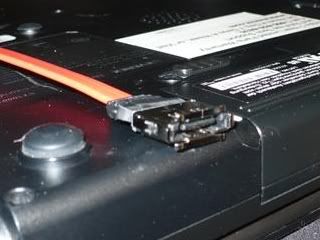jasmineaura
n00b
- Joined
- Jul 18, 2009
- Messages
- 40
Re: the hair dryer, besides the warnings I made in my previous post:
The hair dryer certainly wont put out a high enough temperature (or else it would be a heat gun, not for blow drying human hair)
Here's a little something to corroborate this:
Heat gun Vs. Hair Dryer
http://forums.xbox-scene.com/index.php?showtopic=680938
And finally, from the OP:
So heat gun, cardboard wrapped with aluminum foil with a small square cutout the size of the GPU to concentrate the heat on it only, is the best and most guaranteed way to go
However, I've now seen other tricks
The 200W thermal bulb trick
on HPtx1000 (also with defective Nvidia GPU)
http://www.youtube.com/watch?v=ctHTF3oNdxI
Very well done! But the way I did my in-house bake method, I didn't have to rip the laptop open and down to pieces just to get the heatsink off the GPU to do this.. Only have to open back-panel to use my method, and if it doesn't work, you can always try the heatgun/bulb method
Edit:
One clever commentor on the youtube vid above did something quite similar, but the HP tx1000 owners are luckier, cuz they can remove the CPU/GPU heatsink with only taking off the backpanel... in our case we have to get the motherboard completely out of hte case before being able to detach the GPU heatsink... But it's a good idea anyway, so that you can slap some AS5 or some good silver based thermal paste on the GPU before reattaching the heat sink on it
The hair dryer certainly wont put out a high enough temperature (or else it would be a heat gun, not for blow drying human hair)
Here's a little something to corroborate this:
Heat gun Vs. Hair Dryer
http://forums.xbox-scene.com/index.php?showtopic=680938
Dude lead free solder has a melting point of around 220 degrees celcius.. thats equivalent to about 400 degrees farenheit.
Theres not a hairdryer in the world that gets that hot.. cause think about it. Whats it meant for?? TO DRY YOUR HAIR! If it was 400 degrees your hair would get all kinds of screwed up...
Point is, a hairdryer does not get hot enough to even get NEAR a reflow. An oven is also a bad idea, but its better than a hairdryer!!!
And finally, from the OP:
so the hair dryer fix worked for about 40 hours then e74'd again, i was accually very happy because ive had nothin to do(no job) and i am more entertained by fixing xboxs then actually playing them, im sure that wears off. but anyways i took out the overpowered heatgun(850f) and cooked the motherboard after some careful aluminum foil prep and it fixed my e74, i also did this to a friends broken 360 which had been tortured by the towel trick probably close to 100 times. it was so bad that there when there was green lights the video was all black with small pink squares everywhere. but ya it fixed his too.
So heat gun, cardboard wrapped with aluminum foil with a small square cutout the size of the GPU to concentrate the heat on it only, is the best and most guaranteed way to go
However, I've now seen other tricks
The 200W thermal bulb trick
on HPtx1000 (also with defective Nvidia GPU)
http://www.youtube.com/watch?v=ctHTF3oNdxI
Very well done! But the way I did my in-house bake method, I didn't have to rip the laptop open and down to pieces just to get the heatsink off the GPU to do this.. Only have to open back-panel to use my method, and if it doesn't work, you can always try the heatgun/bulb method
Edit:
One clever commentor on the youtube vid above did something quite similar, but the HP tx1000 owners are luckier, cuz they can remove the CPU/GPU heatsink with only taking off the backpanel... in our case we have to get the motherboard completely out of hte case before being able to detach the GPU heatsink... But it's a good idea anyway, so that you can slap some AS5 or some good silver based thermal paste on the GPU before reattaching the heat sink on it
I wasn't too keen on firing all that heat at my mobo, so I tried turning on the laptop without the heat sink attached, then reassembled, and what do you know, it worked, same procedure only I didn't need to use my heat gun.
Last edited:
![[H]ard|Forum](/styles/hardforum/xenforo/logo_dark.png)





